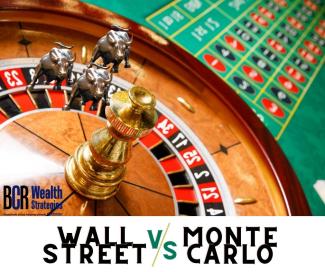
Where Wall Street and Monte Carlo Meet
There’s a class of problems that have no straightforward and definite mathematical solution. A simple example is what is the number that is going to show up on a die when it is next thrown; the answer can only be defined as a probability based on known information. In the example just given we can only say that there is a one-sixth probability that the outcome will be an integer from one to six, so the probability of any given number coming up is one-sixth.
There are more interesting and more complex problems in our lives. Let’s talk about whether a given investment portfolio will provide a given number of loaves of bread for a given number of years. Clearly, there is no straightforward solution to this question. The variables that compound this problem are the return of the portfolio, the rate of inflation, etc.
So, how to solve problems of this kind? One way is to generate a random number (say, portfolio return) to plug into the defined model of the process, and to calculate the result for that random number; this is the simulated return for the first year. Then repeat this process for each year to be simulated; we then have one portfolio possible lifetime return. Then repeat the process many times, using different random numbers each time. After many trials like this, the number of “successful” trials divided by the total number of trials is the probability of “success”. Because of the important use of random numbers, and how many people associate random numbers with gambling, this process is called Monte Carlo simulation. The random numbers are mathematically chosen to reflect past performance of the type of portfolio being employed.
This is the basic process financial advisors use to calculate the probability of success of a particular investment strategy. The random numbers used are annual returns assigned to the portfolio. Each year is assigned a random annual return, and the resulting portfolio value is then used as input for the next year and its return. This will continue until the end of the plan is reached.
Then, this whole process is repeated many times, say 1,000 or 10,000. At this point, the likelihood of “success”, expressed as a percentage, is determined based on the success definition (for example, the portfolio lasts as long as the client).
Monte Carlo simulations are used to get a handle on solutions to problems that have no otherwise solution. With many trials we gain confidence that the simulation bears a resemblance to what might be expected in the “real world”.

